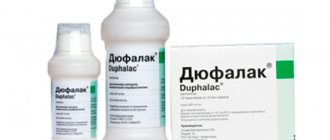A drug from the pharmacological group of laxatives, recommended for all ages due to its mild action, having minimal contraindications - this is a brief description of the drug Duphalac.
Information about how Duphalac works is offered for informational purposes. When planning its use, especially in newborns and infants, as well as in pregnant and lactating women, you should consult your doctor. How does Duphalac work?
The principle of action of the drug
Duphalac is an excellent remedy for normalizing intestinal microflora.
The main active ingredient of the laxative is Lactulose, a carbohydrate consisting of glucose and galactose. It is obtained through deep processing of milk. Lactulose is a substance that stimulates intestinal motility, has a laxative and hypoazotemic effect.
Once in the large intestine, Lactulose is broken down there under the influence of bacteria. The result of this transformation is the formation of organic acids. In the intestine, osmotic pressure increases and pH decreases, ammonium ions are formed.
As a result, the volume of feces increases, the intestinal walls contract more intensely, pushing the contents towards the exit. The structure of feces becomes softer, the process of bowel movement comes into line with physiological rhythms.
A special feature of the drug Duphalac is that it is a prebiotic, normalizing the intestinal microflora and cleansing it of pathogenic microorganisms, that is, it balances the intestinal microbiocenosis. The drug does not have an irritating effect on the intestinal mucosa and smooth muscles of the intestines; it leaves the body through the intestines without being absorbed through its walls.
This medicine does not at all interfere with the absorption of vitamins and other nutrients from food; its principle of action is similar to the action of natural dietary fiber.
About the drug
The drug Duphalac is prescribed for dysbacteriosis.
The laxative effect when taking this hyperosmotic drug is achieved by increasing intestinal motility.
Lactulose is broken down in the colon by its microflora into low molecular weight organic acids, thereby increasing the volume of intestinal contents.
Peristalsis increases, and conditions are created for emptying the colon. This restores the frequency of bowel movements and eliminates constipation.
If Duphalac is used as an adjuvant for hepatic encephalopathy or coma, it can significantly reduce the effect on the brain of toxic substances produced in the large intestine. Acting as a prebiotic, Duphalac restores the balance of intestinal microflora, suppressing the growth of pathogenic microbes such as salmonella, and promoting the growth of lacto- and bifidobacteria.
The absorption of the drug through the walls of the stomach and intestines is practically zero. It enters unchanged into the large intestine, where it is broken down by its microflora. The drug is prescribed for various diseases and conditions:
- Functional constipation.
- Hemorrhoids, operations on the intestines and anal canal (to soften hard stools).
- Hepatic encephalopathy.
- Dysbacteriosis.
- Enteritis.
- Putrid dyspepsia.
- Acute food poisoning.
- Preparation for colonoscopy, irrigoscopy, sigmoidoscopy.
This drug is not used in cases of special sensitivity to its components, as well as in cases of galactosemia and acute intestinal obstruction. Since Duphalac contains lactulose, it is used under special medical supervision for diabetes mellitus and lactose intolerance.
In what cases is the use of the drug indicated?
Duphalac is used to treat constipation.
The range of application of Duphalac is as follows:
- Constipation
- Salmonellosis
- Putrid intestinal dyspepsia
- Enteritis caused by Salmonella
- Preparing for bowel studies
- The need to soften stool during exacerbation of hemorrhoids
- Condition after colon surgery
The main reason for the widespread use of Duphalac as a laxative is that the drug does not cause addiction to it, that is, after eliminating the cause of constipation, the process of bowel movement occurs naturally.
How to take Duphalac correctly
Duphalac is taken orally.
Since Duphalac is available in syrup form, the only possible method of administration is oral. It is taken once, at the same time. Since the effect of the drug occurs after a certain time, it is advisable to ensure that during this time you can freely visit the toilet.
The dose is selected individually, depending on age, reason for using the product, and individual characteristics:
- Constipation in adults – 20-45 ml daily dose, 15-30 – maintenance dose.
- Children from 0 to 5 years – 5-10 ml daily dose, 6-14 ml – 10-15 ml – daily dose.
- Preparation for intestinal examination - 100-150 ml once.
- Dysbacteriosis in newborns – 1.5-3 ml per day
- The effect of a single dose of the drug can last for 1-2 days.
Duphalac
Duphalac ®
(lat.
Duphalac
® ) - osmotic laxative drug, prebiotic.
Duphalac is a solution of the active substance
- lactulose in purified water. 100 ml of solution contains 66.7 g of lactulose. The solution has the appearance of a transparent viscous syrup from colorless to light yellow with a brownish tint. Supplied in bottles of 200 ml, 500 ml and 1000 ml or in the form of 15 ml single-use bags made of polyethylene and aluminum foil.
Duphalac has a hyperosmotic laxative effect, stimulates intestinal motility, improves the absorption of phosphates and Ca2+ salts, and promotes the excretion of ammonium ions. The active substance of Duphalac, lactulose, is broken down by colon bacteria into low molecular weight organic acids, which leads to a decrease in acidity and an increase in osmotic pressure and, as a result, an increase in the volume of intestinal contents. These effects stimulate intestinal motility and affect stool consistency. Constipation disappears and the physiological rhythm of bowel movements is restored. In hepatic encephalopathy or hepatic (pre)coma, the effect is attributed to the suppression of proteolytic bacteria by increasing the number of acidophilic bacteria (eg, lactobacilli); the transition of ammonia into ionic form due to acidification of the contents of the colon; bowel emptying due to a decrease in acidity in the colon and the osmotic effect, as well as a decrease in nitrogen-containing toxic substances by stimulating bacteria that utilize ammonia for bacterial protein synthesis. Inhibits the growth of salmonella in the intestines, shortens the period of bacterial excretion (Instructions for use of Duphalac).
Duphalac (lactulose) is the only laxative
an effective and safe drug in all age groups, approved for use in
pediatric practice
. The most important feature of Duphalac is its prebiotic effect. Prebiotics are partially or completely indigestible food components that selectively stimulate the growth and/or metabolism of one or more groups of microorganisms living in the large intestine, ensuring the normal composition of the intestinal microbiocenosis. From a biochemical point of view, this group of nutrients includes polysaccharides and some oligo- and disaccharides. For microorganisms, they are vital components of their nutrition, sources of energy and plastic material. The most well studied prebiotics are dietary fiber, oligosaccharides, lactose and lactulose. As a result of microbial metabolism of prebiotics in the colon, lactic acid, ortho-chain fatty acids, carbon dioxide, hydrogen, and water are formed. Carbon dioxide is largely converted into acetate, hydrogen is absorbed and excreted through the lungs, and organic acids are utilized by the macroorganism, and their importance for humans is difficult to overestimate. Duphalac, by stimulating the growth of normal intestinal microflora, helps maintain anti-infective protection, in particular against Shigella, Salmonella, Yersinia and rotaviruses. When artificially feeding children with a milk formula containing 1.2 g/100 Kcal of lactulose with a lactose to protein ratio of 2.5:1, an almost pure culture of bifidobacteria is formed in the intestines, and the acidity of the intestinal contents decreases (Belmer S.V. et al.) .
The dose of Duphalac is selected individually, starting with 5 ml once a day. If there is no effect, the dose is gradually increased (by 5 ml every 3-4 days) until the desired effect is obtained. Conventionally, the maximum dose in children under 5 years of age is 30 ml per day, in children 6 - 12 years old - 40 - 50 ml per day, in children over 12 years old and adults - 60 ml per day. The frequency of administration can be 1 - 2 (less often 3) times a day. A course of Duphalac is prescribed for 1 - 2 months, and if necessary - for a longer period. Duphalac is discontinued gradually under control of stool frequency and consistency (Belmer S.V. et al.).
Duphalac, due to its unique properties, is rightfully considered the gold standard of laxatives. It, like other osmotic drugs, is capable of retaining water in the intestinal lumen, proportional to the number of its molecules. Lactulose, the active ingredient in Duphalac, is not metabolized or absorbed in the small intestine because brush border enzymes cannot hydrolyze the bond between galactose and fructose molecules, and it reaches the colon virtually unchanged. Here, under the influence of bacterial enzymes, lactulose decomposes to form short-chain fatty acids (lactic, acetic, propionic and butyric). These organic acids may be absorbed or remain in the intestinal lumen. In the latter case, there is an increase in stool acidity. Having pronounced osmotic activity, organic acids stimulate obligate excretion of water throughout the colon, which does not allow the mucous membrane to absorb the products of enzymatic decomposition of lactulose. As a result of the increase in intraluminal pressure caused by water retention and an increase in the volume of chyme, the peristaltic reflex is initiated and coordinated motor activity is stimulated, which leads to an acceleration of intestinal transit. An additional mechanism for stimulating peristalsis is an increase in the volume of intestinal contents due to an increase in the biomass of bifidobacteria and lactobacilli, the growth of which is stimulated by the products of enzymatic hydrolysis of lactulose. This phenomenon develops much later than the main effects, but makes a significant contribution to the development of the general laxative effect. Enzymatic processes lead to the formation of gas (10 g of lactulose - 1 liter of hydrogen and carbon dioxide), most of which is absorbed into the bloodstream and released with exhaled air. In some patients, the remaining gas may cause bloating. Flatulence is practically the only side effect of Duphalac. In some patients, it can develop 3-4 days after starting to take Duphalac and, as a rule, goes away on its own. In persistent cases, the dose of Duphalac should be reduced to eliminate flatulence. In order to prevent the development of flatulence, it is possible to recommend a gradual increase in the dose of Duphalac from the minimum to the most effective. It should also be remembered that exceeding the daily dose of Duphalac (more than 100 g of lactulose) can lead to severe diarrhea. Standard doses of Duphalac have a mild laxative effect due to lower, compared to other laxatives of this class, osmotic activity and suppression of water reabsorption in the colon (Pasechnikov V.D.). Due to the ability to bind water, the active substance of Duphalac, the synthetic disaccharide lactulose, like other osmotic laxatives, increases the weight of stool, softens the consistency and accelerates the movement of chyme through the colon. However, Duphalac induces gas formation and bloating.
.
Moreover, the intestinal microflora adapts to the daily intake of non-absorbable sugars. This circumstance reduces the effectiveness of Duphalac during long-term treatment and also forces one to constantly increase its dose
to achieve an effect (Makhov V.M., Beresneva L.A.).
If functional constipation occurs in children in the first year of life who are breastfed, it is necessary (for children from 4 months of age) to introduce complementary foods with a high content of dietary fiber. If there is no effect from the dietary correction, it must be combined with drug therapy - lactulose preparations (Duphalak, Normaze, Lactusan, etc.) (Sorvacheva T.N., Pashkevich V.V.).
For patients suffering from chronic liver diseases of any etiology, in order to correct hemodynamic disorders of portohepatic blood flow, provide a hepatoprotective effect, prevent and correct hepatic encephalopathy, long-term, at least six months, maintenance therapy is recommended, including Essentiale N 6 capsules per day, Duphalac 30-50 ml 3 times a day, and propranol or enalapril 10 mg per day or losartan 50 mg per day (Nikushkina I.N.).
About the use of Duphalac before colonoscopy, anorectal and colonic manometry, X-ray diagnostics and surgical interventions on the colon, see: “Preparation of the colon for instrumental studies.”
Professional medical publications concerning the use of Duphalac in the treatment of gastrointestinal diseases:
- Belmer S.V., Gasilina T.V., Khavkin A.I., Eiberman A.S. Functional disorders of the digestive system in children. M., RGMU, 2005.- 36 p.
- Makhov V.M., Beresneva L.A. Systemic factors in chronic constipation // Attending physician. – 2005. – No. 2.
- Pasechnikov V.D. Functional constipation caused by slow transit of intestinal contents // Farmateka. – 2003. – No. 10. – p. 16–23.
- Sorvacheva T.N., Pashkevich V.V. Functional disorders of the gastrointestinal tract in infants: methods of correction // Attending physician. – 2006. – No. 4. – p. 40–46.
- Nikushkina I.N. The state of portal-hepatic blood flow in chronic diffuse liver diseases (interorgan and hemodynamic relationships). Abstract of dissertation. Doctor of Medical Sciences, 14.00.05 - internal diseases. MGMSU, Moscow, 2007.\
On the website gastroscan.ru in the literature catalog there is a section “Laxatives”, containing medical articles relating to laxatives and their use.
Indications for use of Duphalac
:
- constipation: regulation of the physiological rhythm of bowel movements
- softening of stool for medical purposes: presence of hemorrhoids, upcoming surgery on the colon or anus
- hepatic encephalopathy: treatment and prevention of hepatic coma or precoma
- dysbacteriosis
- enteritis caused by salmonella or shigella
- salmonellosis in the stage of bacterial carriage
- in young children - putrefactive dyspepsia syndrome as a consequence of acute food poisoning
Doses of Duphalac for the treatment of constipation and for softening stools:
- adults: initial dose 15 - 45 ml (maintenance dose 10 - 25 ml)
- children 7-14 years old: 15 ml (10 ml)
- children 3-6 years old: 5 - 10 ml (5 - 10 ml)
- children under 3 years: 5 ml (5 ml)
Duphalac is best taken once a day in the morning with meals.
The clinical effect occurs within 1-2 days. The dose can be reduced after two days of use depending on the patient's needs. The dose or frequency of administration is increased if no improvement in the patient’s condition is observed within two days of taking the drug. Doses of Duphalac in the treatment of hepatic coma and precoma
. Initial dose 3 times a day, 30-45 ml. Then they switch to an individually selected maintenance dose, so that the stool is soft 2-3 times a day maximum, so that the acidity of the stool is within the range of 5.0-5.5 pH. In acute cases, Duphalac can be prescribed in the form of enemas in a ratio of 300 ml of Duphalac and 700 ml of water.
Doses for the treatment of intestinal dysbiosis
(prebiotic course):
- children under 1 year 1.5 - 3 ml
- children from 1 year to 3 years – 3 ml
- children from 4 to 7 years old - 5 ml
- children over 7 years old and adults - 10 ml
The minimum duration of the prebiotic course is 1 month with the possible continuous use of Duphalac in the same doses.
Doses for the treatment of salmonellosis, shigellosis
: in the first 10-12 days, 15 ml 3 times a day, after a one-week break at the same dose 5 times a day.
Contraindications
- galactosemia
- intestinal obstruction
- hypersensitivity to lactulose, fructose, galactose or lactose.
Duphalac should be used with caution
in patients with diabetes mellitus.
Duphalac can be prescribed to pregnant and nursing mothers
.
Side effect:
- in the first days of taking Duphalac, flatulence is possible, which usually goes away after two days
- in case of overdose, abdominal pain and diarrhea may occur, which requires a dose reduction
- when using high doses for a long time in the treatment of hepatic encephalopathy, the patient may develop electrolyte imbalance due to diarrhea
- possible flatulence, abdominal pain, nausea, vomiting, and when using high doses - diarrhea
- possible electrolyte imbalance as a consequence of diarrhea
Overdose
may cause abdominal pain and diarrhea. In this case, it will be enough to reduce the dose or stop taking the drug.
Interaction with other drugs
: Due to the mechanism of action of lactulose by increasing colonic acidity, drugs that have a release dependent on colonic acidity (such as 5-aminosalicylic acid preparations) may be inactivated.
special instructions
- If there is no therapeutic effect within two days or if constipation returns after treatment, you should consult your doctor.
- For patients with lactose intolerance, when using this drug, it is necessary to take into account the lactose content in the drug (for 15 ml of syrup, Duphalac contains up to 1.5 g of galactose and up to 0.9 g of lactose).
- the dose typically used for constipation should not pose a problem for patients with diabetes. The dose used in the treatment of hepatic (pre)coma is usually much higher and therefore must be adjusted when prescribed to patients with diabetes mellitus.
- When treated for more than 6 months with increased doses of Duphalac, the level of electrolytes in the blood plasma should be regularly monitored.
- Duphalac therapy does not have or has an insignificant effect on the ability to drive a car and operate machinery (Instructions for use of Duphalac).
Duphalac is an over-the-counter product.
Duphalac is approved for use by official bodies of Russia, Kazakhstan and some other CIS countries.
According to the pharmacological index, Duphalac belongs to the group «
Laxatives." For ATC - to the group “Osmotic laxatives”, code A06AD11.
Manufacturer:
Solvay Pharma, Netherlands.
Other drug brands
with the active substance
lactulose: lactulose poly, lizalak, normase, portlac, romphalac. Back to section
Contraindications, overdose and side effects
Since this laxative contains galactose, glucose, fructose, it is contraindicated for persons with individual intolerance to these components and should be taken with caution by those with diabetes. Additional contraindications are obstruction of the large intestine, rectal bleeding, and the presence of a colostomy.
The drug has no side effects, it is so safe that it can be used in newborns and infants, as well as in pregnant and lactating women. In case of overdose, diarrhea, abdominal pain, increased gas formation, and in very rare cases, vomiting may occur. After stopping taking Duphalac, these phenomena disappear without special therapy.
Taking Duphalac during pregnancy and lactation
Pregnant women may experience bloating when using laxatives.
A frequent companion to pregnancy is chronic constipation. Since this condition negatively affects the condition of a pregnant woman, they require a mild laxative that is absolutely safe for the health of the unborn child.
Use of the drug in infants
Duphalac is used to treat colic in infants.
For babies who are on mixed or artificial feeding, the problem of constipation is far from the least important. An inappropriate formula, the introduction of new complementary foods - the immature intestines can respond to all this with constipation, and, as a result, the baby becomes restless, cries, and develops colic.
An excellent way out of this situation would be to take the laxative Duphalac, which is recommended even for newborns. Such young children can be given the drug using a syringe or spoon. It is better to do this in the morning, during meals, at the same time.
Do not think that by giving your child Duphalac, you no longer have to worry about the problem of constipation. This is an auxiliary temporary remedy, and the cause of stool retention must be eliminated as soon as possible.
Reviews about the action of Duphalac
Duphalac has no side effects.
Reviews about the drug are generally positive, most often it is used by young mothers who note the effectiveness of the product, they value the safety and absence of side effects. A single dose is very suitable for children, the taste is pleasant.
There are also reviews from older people, they like the large volume of the product and its gentle effect. Everyone considers the high price of Duphalac to be a negative point, especially for people with modest incomes.
When using the effective and safe laxative Duphalac, you need to follow the instructions exactly, observe the dosage, and do not take it for a long time. This remedy will be beneficial if you consult a doctor before using it.











